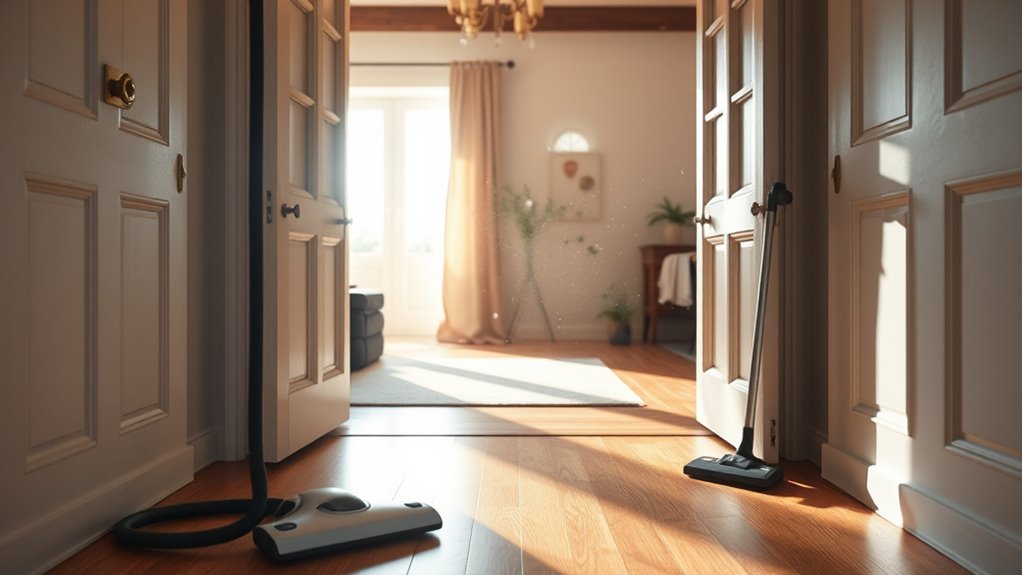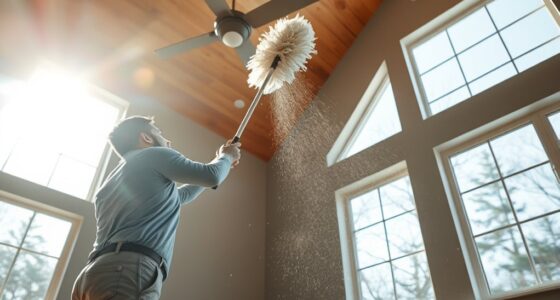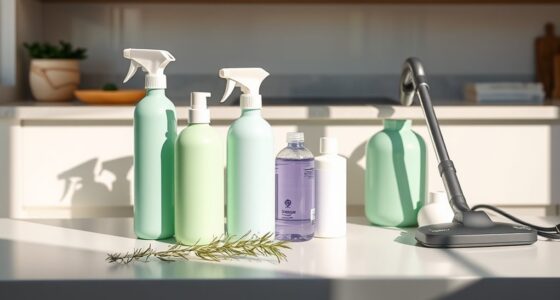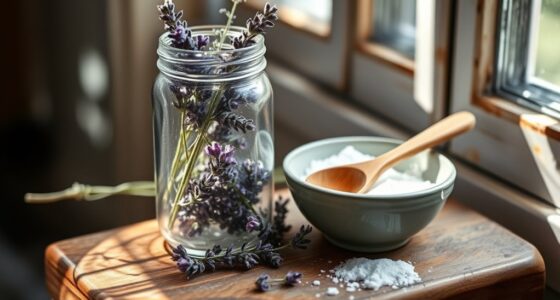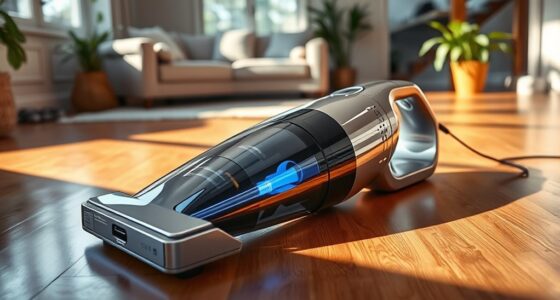After cleaning, it’s best to leave your home long enough for airborne allergens, dust, and chemical fumes to settle. Open windows or run exhaust fans to help clear the air, and plan to stay away for at least 30 minutes to an hour depending on how intensive the cleaning was. Using eco-friendly products and proper ventilation can accelerate this process, so you’ll return to a fresh, safe environment. Continuing this approach ensures your space stays healthier and more comfortable.
Key Takeaways
- Open windows and run exhaust fans during and after cleaning to facilitate airborne particle removal.
- Allow at least 30 minutes to an hour for allergens and dust to settle before leaving.
- Use eco-friendly, low-VOC cleaning products to reduce lingering fumes and irritants.
- Schedule cleaning when you can stay indoors longer to ensure proper ventilation and settling time.
- Incorporate air purifiers if available to enhance indoor air quality before departure.

Leaving home after cleaning can be tricky because you want to make sure everything is in order before you go. One of the biggest concerns is air quality—whether you’ve used strong cleaning products or just tidied up, you don’t want lingering fumes or dust floating around while you’re away. To improve air quality, it’s best to wait a bit after cleaning before leaving. This allows any airborne particles or chemical smells to settle, reducing the risk of inhaling irritants when you return. Ventilating the space by opening windows or running exhaust fans during and after cleaning can help speed up this process, but you should give the air some time to clear before you head out.
Scheduling tips play a *vital* role here. Ideally, plan your cleaning sessions earlier in the day or on days when you’re not leaving immediately afterward. This gives the space enough time to air out, especially if you’ve used products with strong scents or cleaning agents that can impact air quality. If you’re pressed for time, consider doing light cleaning tasks that don’t produce many fumes, like tidying up or dusting, and save deep cleaning for days when you can leave the house for a while afterward. Also, be mindful of your cleaning routine—using eco-friendly, low-VOC products can *considerably* improve indoor air quality and make it safer to leave sooner.
It’s helpful to incorporate scheduling tips into your routine to *guarantee* your home is safe and fresh when you return. For instance, set reminders to open windows right after cleaning, or plan your cleaning sessions during times when you won’t be leaving immediately. If you’re working with a cleaning service, coordinate to clean early in the day so the space has ample time to ventilate before you leave. Remember, the goal is to minimize your exposure to airborne particles and chemical residues, which can be especially important for allergy sufferers or those with respiratory issues. Additionally, understanding how airborne allergens settle into surfaces can help you plan your cleaning routine more effectively.
Another tip is to avoid rushing out immediately after cleaning. Giving yourself at least 30 minutes to an hour, depending on the extent of cleaning, helps the air settle and reduces the chances of allergens or fumes lingering when you’re gone. This pause not only improves your home’s air quality but also ensures that allergens like dust or pet dander have settled into surfaces, making your environment healthier when you return. By planning your cleaning schedule thoughtfully and allowing adequate time for ventilation, you can leave your home feeling confident that it’s safe, fresh, and allergen-free upon your return.
Frequently Asked Questions
How Long Should I Wait Before Re-Entering My Home After Cleaning?
You should wait at least 30 minutes to an hour before re-entering your home after cleaning. This timing considers allergen duration and allows dust and particles to settle. Ventilate the space during this period to reduce airborne allergens. If you used strong cleaning chemicals or allergen triggers, consider waiting longer or increasing ventilation. Being patient helps minimize allergic reactions and guarantees a safer, cleaner environment when you return.
Does Leaving Windows Open Help Allergens Settle Faster?
Opening your windows acts like giving allergens a gentle breeze to carry them away. Ventilation strategies, like timely window opening, help allergens settle faster by dispersing airborne particles. By choosing the right window timing—preferably during dry, breezy conditions—you speed up the cleaning process. So, yes, leaving windows open after cleaning can be effective, but make sure to do so thoughtfully, balancing airflow with outdoor allergen levels.
Are There Specific Cleaning Products That Reduce Allergen Lingering?
Using hypoallergenic cleaners and natural disinfectants can effectively reduce allergen lingering in your home. These products are designed to target allergens without introducing harsh chemicals that might worsen sensitivities. By choosing these options, you help eliminate dust, pet dander, and pollen more thoroughly, creating a healthier environment. Incorporate them into your cleaning routine regularly, and you’ll notice fewer allergens settling in your space over time.
Can Using an Air Purifier Improve Allergen Removal After Cleaning?
Yes, using an air purifier can improve allergen removal after cleaning. The benefits of an air purifier include enhanced allergen filtration, actively capturing airborne particles like dust, pollen, and pet dander. By running it after cleaning, you reduce lingering allergens, creating a healthier environment. Make sure to choose one with a HEPA filter for maximum allergen filtration, and keep it running for several hours to maximize its benefits.
Is It Better to Clean During Certain Times of the Day for Allergens?
Time is of the essence, so choose your cleaning time wisely. Cleaning early in the day minimizes exposure to allergy triggers that tend to settle overnight. Timing considerations matter because allergens like dust and pollen can be more active during certain periods. By cleaning in the morning, you allow your home to air out during the day, reducing allergen buildup and creating a healthier environment for you.
Conclusion
Leave lingering allergens behind by letting fresh air flow freely after cleaning. Giving your home time to settle and scents to disperse ensures a healthier, happier space. Don’t rush back too soon—pause, breathe, and allow dust and dirt to disappear. By practicing patience and prioritizing proper post-cleaning precautions, you protect your health and promote a pristine environment. Remember, a few moments of mindful waiting make a massive difference for your home’s hygiene and your well-being.
